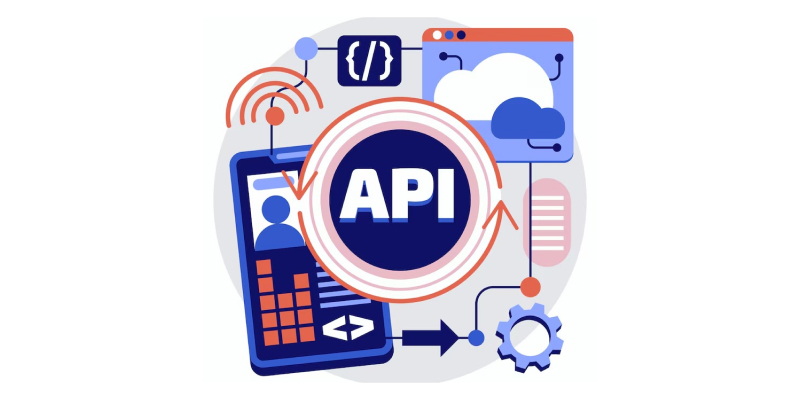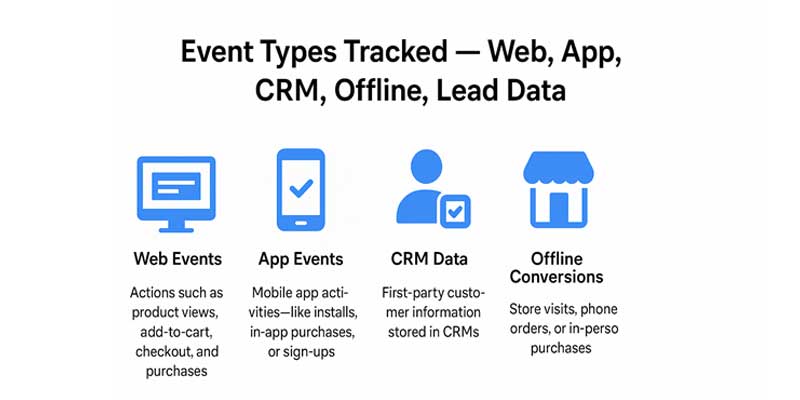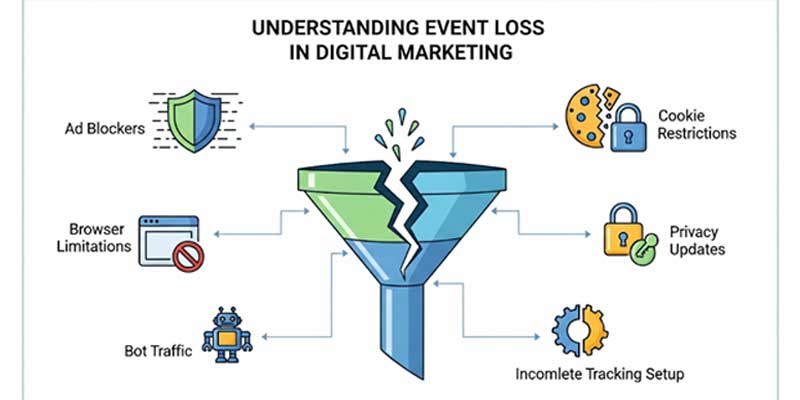

Businesses exhausted in the digital advertising field require powerful tracking systems to verify their advertising activities perform as intended. The Meta Conversion API system delivers businesses an effective tracking solution for conversions which protects privacy while maintaining efficiency. This blog introduces Meta Conversion API operation as well as its essential nature and the substantial impact it provides for advertising results.
Through its Meta Conversion API (CAPI), businesses can send web and offline event data directly to Meta’s servers at the server level. Businesses can receive precise data through CAPI because this tracking solution functions outside of browser restrictions and ad blockers. The Meta ad tracking system allows advertisers to monitor user interactions at their website applications or offline stores more effectively. The direct data-sharing process does away with signal-loss errors to produce more accurate marketing data.
Originally launched as the Facebook Conversions API (CAPI), it evolved into the Meta Conversions API after Facebook’s rebrand to Meta. Over time, the API has expanded to support not just website interactions but also app events, offline conversions, CRM data, and lead information. This makes it a versatile solution for marketers aiming to capture a complete view of customer actions across multiple touchpoints.
The shift toward server-to-server tracking reflects a broader trend in digital marketing—moving away from dependency on cookies and browser signals, and toward first-party, consent-driven data sharing.
Meta introduced the Conversions API in response to a changing digital landscape where privacy regulations and browser changes were eroding the effectiveness of traditional tracking methods. Updates like Apple’s iOS 14.5 privacy framework and browser-level restrictions such as Safari’s Intelligent Tracking Prevention (ITP) significantly reduced the accuracy of cookie-based data collection.
This shift left advertisers struggling with incomplete attribution, event loss, and rising customer acquisition costs. By creating a direct, server-side connection, the Meta Conversions API helps businesses:
In essence, Meta designed the Conversions API to future-proof ad measurement and empower advertisers with cleaner, more reliable insights in a privacy-first world.

The Facebook Pixel function of traditional tracking depends on users allowing their browsers to communicate with Meta databases. The transmission between browsers and Meta can stop because of ad blockers alongside browser limitations and cookie restrictions.
Business servers link up directly with Meta's servers through the Meta Conversion API. It is also evident that with Meta Conversion API users can transmit essential conversion events that consist of purchase sign-ups and leads independently of browser tracking. With this interface, users who deny cookie access or use browsers for privacy can still get their interactions with your ads tracked correctly.
The Meta Conversions API works on a server-to-server (S2S) data flow, which makes it fundamentally different from the traditional Meta Pixel that relies on client-side tracking.
With the Pixel, events such as page views, purchases, or sign-ups are captured in the user’s browser and then sent to Meta. However, this method is increasingly unreliable because of factors like cookie restrictions, ad blockers, and privacy-driven changes in operating systems (e.g., iOS 14+). These limitations often lead to data loss, incomplete attribution, and higher advertising costs.
In contrast, the Conversions API bypasses these restrictions by sending event data directly from a business’s server to Meta’s systems. This server-side integration ensures more stable and accurate event delivery, unaffected by browser-level disruptions. It also allows advertisers to enrich their data with additional customer signals (e.g., hashed email or phone numbers) to improve match rates and attribution accuracy.
By combining both methods—Pixel for client-side interactions and CAPI for server-side reliability—businesses achieve a holistic tracking approach that reduces data gaps and provides more trustworthy insights.
The Meta Conversions API isn’t limited to just website interactions. It’s designed to capture a wide variety of event types across customer touchpoints:

This multi-channel tracking ability makes the Conversions API a comprehensive measurement solution, enabling businesses to see the bigger picture of how ads drive real-world results.
One of the biggest advantages of the Meta Conversions API is its resilience against data loss caused by ad blockers or browser-based restrictions like Safari’s Intelligent Tracking Prevention (ITP). Since data is transmitted directly from a server instead of relying on cookies or browser scripts, advertisers can capture more reliable conversion events. This ensures ad spend is optimized based on accurate performance data rather than incomplete tracking signals.
Traditional tracking often struggles to show how upper-funnel interactions (like product views or newsletter sign-ups) contribute to final sales. With the Conversions API, businesses can send customized event data throughout the customer journey, from initial engagement to purchase or subscription. This leads to improved attribution models and a more accurate understanding of how different ads and touchpoints influence conversions.
Many conversions happen outside of a website or app, such as phone orders, in-store purchases, or B2B lead follow-ups. The Conversions API makes it possible to connect offline events and CRM data directly to Meta ads. For example, a sales call that closes a lead generated from a Facebook campaign can be tracked back to the ad source. This holistic tracking helps businesses measure the true ROI of campaigns across both online and offline channels.

In an era of heightened data privacy, businesses need solutions that allow greater control over what data is shared. The Meta Conversions API allows advertisers to send only the necessary, consented data, often in a hashed and secure format. This ensures compliance with global regulations like GDPR and CCPA, while still enabling advertisers to improve audience targeting and measurement. By owning the data flow, brands reduce reliance on third-party cookies and maintain stronger privacy safeguards.
As browsers and operating systems continue to implement stricter privacy measures, client-side tracking will only become less reliable. The Conversions API provides a future-proof solution by enabling server-side, first-party data sharing that isn’t subject to the same limitations. This adaptability ensures that businesses can continue to optimize campaigns effectively even as the digital ecosystem evolves.
The Meta Pixel is a client-side tool that collects data through a user’s browser whenever they take an action, such as clicking a button, adding to cart, or making a purchase. While it has been the backbone of Meta’s ad tracking for years, it depends heavily on cookies and browser functionality.
The Meta Conversions API (CAPI), on the other hand, uses a server-side integration. Instead of relying on the browser, businesses send data directly from their own servers to Meta. This makes tracking more reliable, as it is less impacted by browser restrictions, network issues, or user-side blocking.
In simple terms:
The Pixel faces significant challenges in today’s privacy-first digital environment. Common causes of event loss include:

These limitations often lead to incomplete data and underreporting of campaign performance, which can affect budget allocation and optimization strategies.
The strongest approach isn’t choosing between Pixel and CAPI, but using both together. Meta recommends a hybrid strategy where the Pixel continues capturing browser-side events, while the Conversions API sends the same events server-side.
However, sending the same event twice (once from Pixel, once from CAPI) creates the risk of duplicate reporting. To solve this, Meta uses event deduplication, where shared identifiers (such as Event Name and Event ID) tell the system that two signals represent the same action. This ensures advertisers get one clean, accurate record per event.
By pairing Pixel and CAPI with proper deduplication, businesses maximize data reliability, reduce tracking gaps, and maintain a more complete view of the customer journey.
Meta offers several ways to set up the Conversions API depending on your technical resources:
Choosing the right integration path depends on your business size, technical capability, and data sources.
For businesses without in-house developers, Meta provides additional options:
The Facebook Conversion API integration comes with various deployment options for websites. Platform Partners such as Shopify, WordPress and WooCommerce collaborate with Meta for simple implementation of CAPI through their platforms. Users who operate through the designated platforms can activate CAPI using their built-in settings.
A developer must implement Facebook Conversion API through manual settings via Meta's Event Manager and API reference material for websites with custom code. The implementation of advanced ad tracking tools through third-party tools such as Google Tag Manager and Zapier avoids complex coding requirements.
An access token serves as the essential requirement to link a server with Meta. The access token becomes available in Meta’s Event Manager which you can find under the “Settings” tab of your ad account.
Select the specific events you wish to monitor from the list of available options that include purchase leads and add-to-cart actions. The tracking done by your Meta ad tracking pixel events needs to correspond exactly with the ones you choose to analyze from your server.
Meta does not provide API documentation which enables servers to transmit event data towards Meta's servers. Hash the event parameters which include user email or phone numbers before transmission to protect their privacy.
Use the Event Manager feature of Meta to verify your integration after finishing the setup procedure. Verify the data transmission accuracy through testing and address all problems before starting your campaigns.
The Meta Conversions API works best when combined with the Meta Pixel. While the Pixel captures browser-side actions, the API ensures server-side reliability. To avoid double counting, always implement event deduplication. This involves assigning a unique Event ID to both Pixel and CAPI events, allowing Meta to recognize them as the same action and count them only once.
Meta supports a set of standard events (e.g., Purchase, AddToCart, Lead, CompleteRegistration). Using the correct names ensures smoother integration with Meta’s optimization and attribution systems. Avoid using vague or custom event names unless absolutely necessary, and ensure that events truly reflect qualifying actions that impact your campaign goals.
To improve event match quality, businesses should share customer identifiers such as email addresses, phone numbers, or IP addresses. However, this data must be hashed using SHA-256 before sending, ensuring compliance with privacy regulations. Supplying multiple identifiers (e.g., both email and phone) increases the chances of accurately matching conversions to Meta users.
The process of Meta ad tracking needs ongoing surveillance to achieve peak performance outcomes. A continuous review of the Meta Event Manager allows users to detect any mistakes and optimize event parameters for higher precision. The use of advanced ad tracking tools, such as CAPI, when combined with traditional methods, provides businesses with improved data collection while enhancing campaign efficiency. Business entities offering Conversion Rate Optimization Services benefit from optimized Meta Conversion API implementation since it helps them make data-driven choices which produces better ad results and improves their Return on Investment.
When implementing the Meta Conversions API, choosing the right integration method is critical for smooth performance and sustainable management. Businesses with strong in-house development resources may prefer a direct server-to-server setup for full flexibility and control. On the other hand, companies that rely on marketing tools like Shopify, HubSpot, Salesforce, or Google Tag Manager can leverage partner integrations that simplify configuration and maintenance. Selecting a method that aligns with your technical expertise, budget, and infrastructure ensures that events flow reliably without unnecessary complexity.
Meta frequently updates its Conversions API framework, introducing new features, stricter requirements, and improved event-matching capabilities. To maintain accuracy and compliance, businesses should regularly review their integration within Meta Events Manager and adjust according to the latest guidelines. This includes updating SDKs, refreshing access tokens, enabling new event parameters, and adopting enhanced matching options. Keeping your setup updated not only ensures ongoing data quality and compliance with privacy laws but also future-proofs your campaigns as Meta adapts to evolving browser restrictions and industry shifts.
In 2025, leveraging the Meta Conversions API has become essential for businesses that want to thrive in a privacy-first digital advertising landscape. For businesses with limited technical bandwidth, the fastest path to setup is through Meta’s Gateway, Signals Gateway, or certified partner tools, which streamline deployment without requiring deep coding expertise. Larger teams with robust developer resources can pursue custom integrations for greater control and flexibility. However, setting up is only the beginning. Long-term success depends on continuous monitoring, optimization, and compliance. This includes verifying events through Meta’s Test Events tool, refining match quality, preventing double counting, and staying aligned with Meta’s updates. Utilization of Conversion API by businesses teamed with any Facebook ad agency India creates substantial benefits for advertising campaigns. You can also utilise this and make your brand successful!